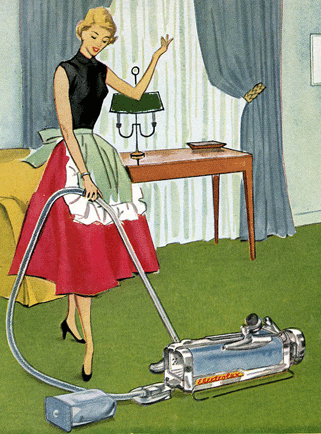|
Thread Number: 34387
/ Tag: Brand New Vacuum Cleaners
Watts vs. Amps |
[Down to Last] |  |
| Post# 372267 5/17/2017 at 14:14 (2,528 days old) by Shrink1982 (Indianapolis) | ||
 | ||
| Post# 372286 , Reply# 2 5/17/2017 at 19:42 (2,528 days old) by wyaple (Pickerington, OH) | ||
David,
Your Kirby Diamond has a rating plate and it will say:
120V~ 50-60 Hz 7A And I hope your new expensive Maytag DOESN'T say "12.5 watts" as stated in your above post. To answer your question, as best as I can figure, Americans have been at 120 Volt system for so long, why bother to give a Watt rating? Just give the Amperage as it is an easier to understand single, non-calculated number. The rest of the world can handle Wattage, which is calculated by: Volts X Amps = Watts I'm betting that it's easier to give a total power figure because more than one voltage standard exists. Some countries have 100, 110, 120, 220, 230, 240 voltage standards. Here's a complete list to boggle the mind... Bill CLICK HERE TO GO TO wyaple's LINK | ||
| Post# 372303 , Reply# 3 5/18/2017 at 07:54 (2,527 days old) by eurekaprince (Montreal, Canada) | ||

It may be that Europe is the birthplace of the canister / cylinder vacuum and they have been much more focused on improving the features related to suction and airflow compared to North America. One of the main differences in canister design between the two sides of the ocean is the variable speed motor. It has always been far more common in Europe to see canister vacuums offering variable speed motors which use an onboard voltage transformer to adjust from the maximum 240 volts down to more gentle settings. You will often see the adjuster labelled by wattage for the settings on these European canisters: 1400 watts, 1000 watts, 600 watts, etc.
In comparison, North American canisters have rarely offered "Electronic Speed Control" - and often only on the deluxe top-of-the-line models. Our canisters more often offer mechanical suction relief valves to adjust suction. So it's easier to just show the single amperage of the motor (12 amps, etc). Before the 1980's, our canister vacs were rated by horsepower - with 3 or 4 HP being quite powerful. Can't remember how horsepower ratings are derived, though. | ||
| Post# 372304 , Reply# 4 5/18/2017 at 08:47 (2,527 days old) by wyaple (Pickerington, OH) | ||
Peak HP Ratings Are Mostly
Completely made up numbers unfortunately. ShopVac still uses them BUT, they have to report actual steady state HP/Amp ratings as well.
1 HP = 746 Watts, so the max steady state HP any North American machine could have plugged into a standard 15 Amp outlet would be 1800 Watts / 746 Watts/HP = 2.41 HP. So when you see anything higher than about 2.5 HP, you know it's based on a peak turn on current surge that lasts for just a few milliseconds that won't pop the breaker. But I'm very glad that those ridiculous peak HP ratings are largely gone now along with the equally useless "Cleaning Effectiveness Per Amp" ratings from the glorious 80s and 90s. Also, how much power a vacuum uses has pretty much no relation to actual cleaning power, usually expressed in CFM. If manufacturers would post CFM at the hose or nozzle, consumers would probably buy different machines pretty quickly. Imagine a 12 Amp (1440 Watt) clean air machine that only produces 50 CFM at the nozzle that sells for $800. Then compare that to a cheap $70 machine produces 80 CFM at the nozzle. Which one would fly off the shelves now? Bill | ||
| Post# 372314 , Reply# 5 5/18/2017 at 10:30 (2,527 days old) by sebo4me (Cardiff) | ||
 | ||
| Post# 372315 , Reply# 6 5/18/2017 at 10:32 (2,527 days old) by sebo4me (Cardiff) | ||
 | ||

 Comes to the Rescue!
Comes to the Rescue!